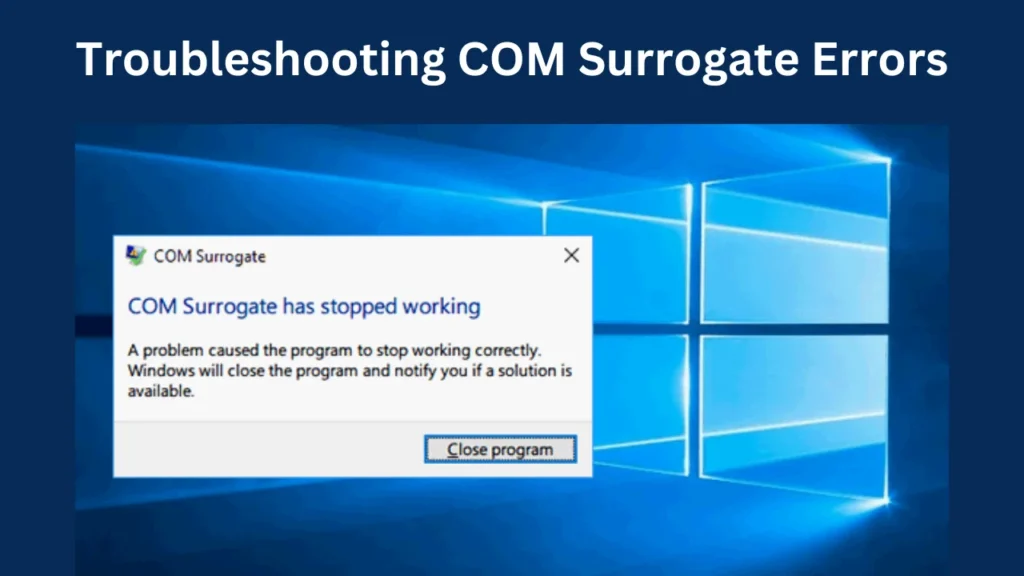COM Surrogate Virus or Not? Identify and Resolve Issues

If you have ever encountered an error message saying, “COM Surrogate has stopped working,” you might wonder what this mysterious process is and why it seems to cause issues. The term COM Surrogate may sound technical, but understanding its role and significance in the Windows operating system can help you resolve errors effectively.
In this article, we will explore what it is, why it exists, and how to troubleshoot problems related to it. By the end, you’ll have a clear understanding of this vital component and how it impacts your computer’s performance.
Read More About Journalist and Other Celebrities Biography at Misty Severi Website.
What is com surrogate?
COM Surrogate, represented by the dllhost.exe process in Windows, is a vital system component that hosts and manages Component Object Model (COM) objects. It allows potentially unstable tasks, like generating thumbnails for media files, to run in isolation from the main process, such as File Explorer, to prevent system crashes. Essentially, it acts as a sacrificial process, ensuring that if something goes wrong with the COM object, the Surrogate process crashes instead of the primary application. While it is a legitimate and essential part of the Windows operating system, malware can sometimes disguise itself as Surrogate, posing a security risk. It is not a virus but a protective mechanism to enhance system stability and performance.
The Role of COM Surrogate in Windows
It is represented by the dllhost.exe process, is an essential part of the Windows operating system. It serves as a host for Component Object Model (COM) objects, which are small pieces of code that allow programs to perform specific tasks. These objects often run outside the main process to ensure system stability.
For instance, when you open a folder in File Explorer, it helps generate thumbnails for files such as images or videos. This separation ensures that if the thumbnail generation crashes, it doesn’t affect the main File Explorer process. In essence, it is like a safety net, isolating potentially unstable tasks to keep your system running smoothly.
Read Also: Esther Krakue Early Life, Education and career
Why Does COM Surrogate Cause Errors?
Despite its importance, it can sometimes lead to errors. One of the most common issues is the “it has stopped working” error. This happens when the task handled by COM Surrogate, such as generating thumbnails, fails. The primary reasons for this include:
Outdated Codecs: Media files rely on codecs to render properly. If these codecs are outdated or corrupted, it may crash.
Malware: Some viruses mimic the dllhost.exe process, causing system instability and security risks.
Faulty Software Extensions: Poorly designed extensions can trigger errors when executed through it.
Understanding these causes can help you pinpoint the root of the problem and implement the right solution.
Is COM Surrogate a Virus?
One of the most common concerns users have is whether it is a virus. The short answer is no. It is a legitimate Windows process, essential for running certain tasks. However, malware can disguise itself as COM Surrogate by replicating the dllhost.exe file. This fake process can lead to high CPU usage, system crashes, or even data theft.
To verify if your system is safe, open the Task Manager, locate the Surrogate process, and check its file location. If the file resides in the System32 folder, it is legitimate. If not, it could be malicious, and you should scan your system with updated antivirus software.

Troubleshooting COM Surrogate Errors
If you encounter issues with COM Surrogate, several solutions can help restore functionality. Here are some effective methods:
Update Codecs
Since outdated codecs are a leading cause of COM Surrogate crashes, updating them can resolve the issue. You can install a trusted codec pack or update your media player to the latest version.
Scan for Malware
A comprehensive antivirus scan can detect and remove malicious files masquerading as COM Surrogate. Ensure your antivirus software is up-to-date for optimal protection.
Reset System Setting
In some cases, resetting your system’s default settings, such as rolling back drivers or re-registering DLL files, can fix COM Surrogate errors.
Disable Thumbnails
Disabling thumbnail generation in File Explorer can eliminate the tasks that often cause it to crash. To do this, go to Folder Options and select “Always show icons, never thumbnails.”
How to Prevent COM Surrogate Issues
Prevention is always better than cure, especially when it comes to system processes like COM Surrogate. Here are some tips to keep your system running smoothly:
| Tip | Why It’s Important |
|---|---|
| Keep Software Updated | Regular updates ensure compatibility and reduce the risk of errors caused by outdated code. |
| Use Reliable Antivirus | Protects your system from malware that mimics COM Surrogate. |
| Avoid Untrusted Downloads | Downloads from insecure sites can introduce harmful files disguised as system processes. |
| Regularly Scan Your System | Periodic scans help identify and remove threats before they cause significant damage. |
By following these practices, you can minimize the risk of encountering COM Surrogate-related issues.
Why Are There Multiple COM Surrogate Processes?
It’s common to see more than one COM Surrogate process running in the Task Manager. This is because Windows creates separate instances of it for different tasks. For example, one instance might handle thumbnail generation, while another processes video previews. Each instance is isolated to protect the stability of the system.
However, if you notice excessive CPU or memory usage from multiple COM Surrogate processes, it may indicate an underlying problem, such as malware or a poorly designed extension.
Read Also: Chantal Nchako: Cameroonian Actress and Director
Common Myths About COM Surrogate
There are several misconceptions about it. One of the most widespread is that it’s unnecessary and can be disabled. In reality, disabling it can severely impact your system’s functionality, leading to issues with file previews and software performance.
Another myth is that all COM Surrogate errors stem from viruses. While malware is a potential cause, most errors are related to outdated software or codecs. Proper maintenance and updates can often resolve these issues without drastic measures.
Conclusion
It plays a vital role in ensuring the stability and efficiency of the Windows operating system. By isolating high-risk tasks, it prevents system crashes and keeps your computer running smoothly. However, errors related to It can disrupt this balance, often due to outdated codecs, malware, or faulty extensions.
Understanding what it does and how to troubleshoot its errors is key to maintaining a healthy system. Whether it’s updating codecs, scanning for malware, or disabling thumbnails, there are practical steps you can take to resolve issues. Remember, the COM Surrogate process is not a virus, but vigilance is essential to ensure your system remains secure and efficient.






